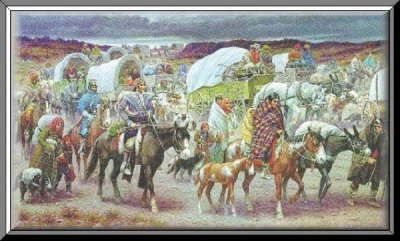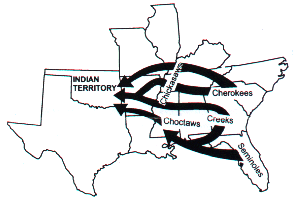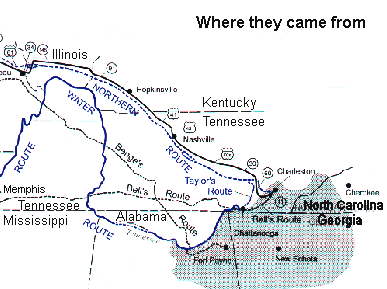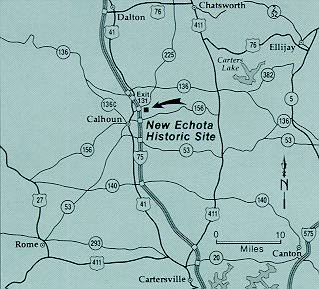|
Trail of Tears Timeline |
|---|
|
1838 |
| February | 15,665 people of the Cherokee Nation petition congress protesting the Treaty of New Echota. |
| March | Outraged American citizens throughout the country petition congress on behalf of the Cherokee. |
| April | Congress tables petitions protesting Cherokee removal. Federal troops ordered to prepare for roundup. |
| May | Cherokee roundup begins May 23, 1838. Southeast suffers worst drought in recorded history. Tsali escapes roundup and returns to North Carolina. |
| June | First group of Cherokee driven west under Federal guard. Further removal aborted because of drought and "sickly season." |
| July | Over 13,000 Cherokee imprisoned in military stockades awaiting break in drought. Approximately 1500 die in confinement. |
| August | In Aquohee stockade, Cherokee chiefs meet in council, reaffirming the sovereignty of the Cherokee Nation. John Ross becomes superintendent of the removal. |
| September | Drought breaks: Cherokee prepare to embark on forced exodus to Indian Territory in Oklahoma. Ross wins additional funds for food and clothing. |
| October | For most Cherokee, the "Trail of Tears" begins. |
| November | Thirteen contingents of Cherokee cross Tennessee, Kentucky and Illinois. First groups reach the Mississippi River, where crossing is held up by river ice floes. |
| December | Contingent led by Chief Jesse Bushyhead camps near present day Trail of Tears Park. John Ross leaves Cherokee homeland with last group: carrying the records and laws of the Cherokee Nation. 5000 Cherokee trapped east of the Mississippi by harsh winter; many die. |
|
1839 |
| January | First overland contingents arrive at Fort Gibson. Ross party of sick and infirmed travel from Kentucky by riverboat. |
| February | Chief Ross's wife, Quati, dies near Little Rock, Arkansas on February 1. |
| March | Last group headed by Ross, reaches Oklahoma. More than 3000 Cherokee die on Trail of Tears, 1600 in stockades and about the same number en route. 800 more die during 1839 in Oklahoma. |
| April | Cherokee build houses, clear land, plant and begin to build a new nation. |
| May | Western Cherokee invite new arrivals to meet to establish a united Cherokee government. |
| June | Old Treaty Party leaders attempt to foil reunification negotiations between Ross and Sequoyah. Treaty Party leaders Major John Ridge and Elias Boudinot assassinated. |
| July | Cherokee Act of Union brings together the eastern and western Cherokee Nations on July 12, 1839. |
| August | Stand Watie, Brother of Boudinot, pledges revenge for deaths of party leaders. |
| September | Cherokee constitution adopted on September 6, 1839. Tahlequah established as capital of the Cherokee Nation. |




